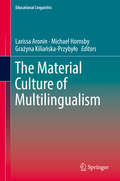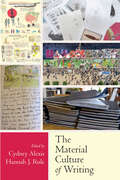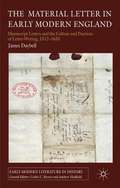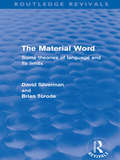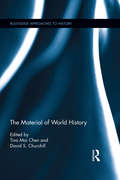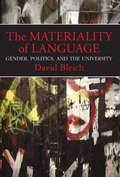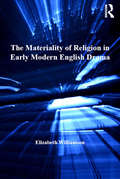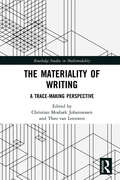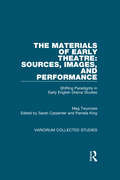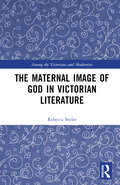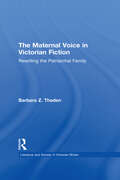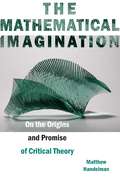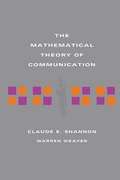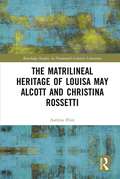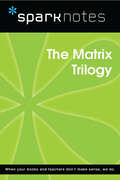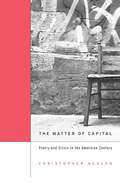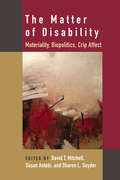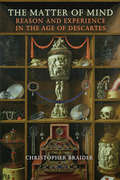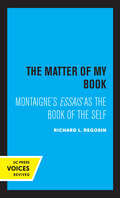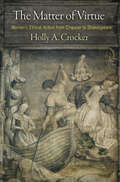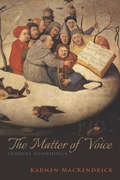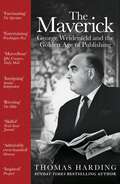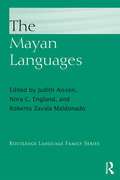- Table View
- List View
The Material Culture of Multilingualism (Educational Linguistics #36)
by Larissa Aronin Michael Hornsby Grażyna Kiliańska-PrzybyłoThis volume provides a unique interface between the material and linguistic aspects of communication, education and language use, and cuts across traditional disciplinary boundaries, drawing on fields as varied as applied linguistics, ethnology, sociology, history and philosophy. Taking texts, images and objects as their starting points, the authors discuss how cultural context is envisioned in particular materialities and in a variety of contexts and localities. The volume, divided into three sections, aims to deal with material culture not only in the daily language practices of the past and the present, but also language teaching in a number of settings. The main thrust of the volume, then, is the exposure of natural ties between language, cognition, identity and the material world. Aimed at undergraduates, postgraduates and scholars in fields as varied as education, applied linguistics, sociolinguistics, semiotics and other related disciplines, this volume documents and analyses a wide range of case studies. It provides a unique take on multilingualism and expands our understanding of how materialities permit us new and unexpected insights into multilingual practices.
The Material Culture of Writing
by Cydney Alexis Hannah J. RuleThe Material Culture of Writing opens up avenues for understanding writing through scholarship in material culture studies. Contributors to this volume each interrogate an object, set of objects, or writing environment to reveal the sociomaterial contexts from which writing emerges. The artifacts studied are both contemporary and historical, including ink, a Victorian hotel visitors’ book, Moleskine notebooks, museum conservators’ files, an early twentieth-century baby book, and a college campus makerspace. Close study of such artifacts not only enriches understanding of what counts as writing but also offers up the potential for rich current and historical inquiry into writing artifacts and environments. The collection features scholars across the disciplines—such as art, art history, English, museum studies, and writing studies—who work as teachers, historians, museum curators/conservators, and faculty. Each chapter features methods and questions from contributors’ own disciplines while at the same time speaking to writing studies’ interest in writers, writing identity, and writing practice. The authors in this volume also work with a variety of methodologies, including literary analysis, archival research, and qualitative research, providing models for the types of research possible using a material culture studies framework. The collection is organized into three sections—Writing Identity, Writing Work, Writing Genre—each with a contextualizing introduction from the editors that introduces the chapters themselves and imagines possible directions for writing studies research facilitated by material culture studies. The Material Culture of Writing serves as an accessible introduction to work in material culture studies for writing studies scholars, graduate students, and undergraduates, especially as it makes a distinctive contribution to writing studies in its material culture studies approach. Because of the interdisciplinarity of material culture studies and this volume’s contributors, this collection will appeal to a wide range of scholars and readers, including those interested in writing studies, the history of the book, print culture, genre studies, archival methods, and authorship studies. Contributors: Cydney Alexis, Debby Andrews, Diane Ehrenpreis, Keri Epps, Desirée Henderson, Kevin James, Jenny Krichevsky, Anne Mackay, Emilie Merrigan, Laura R. Micciche, Hannah J. Rule, Kate Smith
The Material Letter in Early Modern England
by James DaybellThe first major socio-cultural study of manuscript letters and letter-writing practices in early modern England. Daybell examines a crucial period in the development of the English vernacular letter before Charles I's postal reforms in 1635, one that witnessed a significant extension of letter-writing skills throughout society.
The Material Word: Some theories of language and its limits (Routledge Revivals)
by David Silverman Brian TorodeFirst published in 1980, this reissue is a study of the sociology of language, which aims to bridge the gap between textbook and monograph by alternating chapters of explication and analysis. A chapter outlining a particular theory and suggesting general criticisms is followed by a chapter offering an original application of that theory. The aim of the authors is to treat text and talk as the site of specific practices which sustain or subvert particular relations between appearance and reality.
The Material of World History (Routledge Approaches to History)
by Tina Mai Chen David S. ChurchillThis volume considers the confluence of World History and historical materialism, with the following guiding question in mind: given developments in the field of historical materialism concerned with the intersection of race, gender, labour, and class, why is it that within the field of World History, historical materialism has been marginalized, precisely as World History orients toward transnational socio-cultural phenomenon, micro-studies, or global histories of networks? Answering this question requires thinking, in an inter-related manner, about both the development of World History as a discipline, and the place of economic determinism in historical materialism. This book takes the position that historical materialism (as applied to the field of World History) needs to be more open to the methodological diversity of the materialist tradition and to refuse narrowly deterministic frameworks that have led to marginalization of materialist cultural analysis in studies of global capitalism. At the same time, World History needs to be more self-critical of the methodological diversity it has welcomed through a largely inclusionary framework that allows the material to be considered separately from cultural, social, and intellectual dimensions of global processes.
The Materiality of Language: Gender, Politics, and the University
by David BleichA critique of male-dominated modes of language use, their roots in higher education, their effects, and their spill over into popular culture.David Bleich sees the human body, its affective life, social life, and political functions as belonging to the study of language. In The Materiality of Language, Bleich addresses the need to end centuries of limiting access to language and its many contexts of use. To recognize language as material and treat it as such, argues Bleich, is to remove restrictions to language access due to historic patterns of academic censorship and unfair gender practices. Language is understood as a key path in the formation of all social and political relations, and becomes available for study by all speakers, who may regulate it, change it, and make it flexible like other material things.“A potentially foundational text in an emergent field [of] language studies, whose work is to break up the monopoly Linguistics and Philosophy have had on the study of language. . . . The insight that the affective operation of language is elided in nearly all approaches to [language] acquisition is brilliant and astounding. . . . The analysis of subject creation as an affective process of recognizing and sharing the same affective state and language as the means for materializing affective states . . . is fascinating and persuasive. . . . One of the book’s distinctive features is the use of gender as a key normative analytical lens throughout. It would be difficult to exaggerate how rare this is among language thinkers, and how productive it is for the arguments here.” —Mary Louise Pratt, New York University“A powerful, first-rate book on a crucial topic. It offers a great interpretation of the sacralization and ascendancy of Latin as a language supporting what Bleich calls ‘an elite group of men.’ . . . This is a brilliant codebook to academic language and its coercions.” —Dale Bauer, University of Illinois/DESC>literary theory;semiotics;literary criticism;philosophy;language philosophy;philosophy of language;gender studies;social science;language studies;communication studies;language arts;language disciplines;gender;sex;language;rhetoric;academic language;colloquial language;language political aspects;language sex differences;language and genderLIT006000 LITERARY CRITICISM / Semiotics & TheoryPHI038000 PHILOSOPHY / LanguageSOC032000 SOCIAL SCIENCE / Gender StudiesLAN004000 LANGUAGE ARTS & DISCIPLINES / Communication Studies 9780253016508Well-Tempered Woodwinds: Friedrich von Huene and the Making of Early Music in a New WorldGeoffrey Burgess
The Materiality of Religion in Early Modern English Drama (Studies In Performance And Early Modern Drama Ser.)
by Elizabeth WilliamsonThe Materiality of Religion in Early Modern English Drama is the first book to present a detailed examination of early modern theatrical properties informed by the complexity of post-Reformation religious practice. Although English Protestant reformers set out to destroy all vestiges of Catholic idolatry, public theater companies frequently used stage properties to draw attention to the remnants of traditional religion as well as the persistent materiality of post-Reformation worship. The Materiality of Religion in Early Modern English Drama explores the relationship between popular culture and theatrical performance by considering the social history and dramatic function of these properties, addressing their role as objects of devotion, idolatry, and remembrance on the professional stage. Rather than being aligned with identifiably Catholic or Protestant values, the author reveals how religious stage properties functioned as fulcrums around which more subtle debates about the status of Christian worship played out. Given the relative lack of existing documentation on stage properties, The Materiality of Religion in Early Modern English Drama employs a wide range of source materials-including inventories published in the Records of Early English Drama (REED) volumes-to account for the material presence of these objects on the public stage. By combining historical research on popular religion with detailed readings of the scripts themselves, the book fills a gap in our knowledge about the physical qualities of the stage properties used in early modern productions. Tracing the theater's appropriation of highly charged religious properties, The Materiality of Religion in Early Modern English Drama provides a new framework for understanding the canonization of early modern plays, especially those of Shakespeare.
The Materiality of Writing: A Trace Making Perspective (Routledge Studies in Multimodality)
by Christian Mosbæk Johannessen Theo van LeeuwenThis book examines the materiality of writing. It adopts a multimodal approach to argue that writing as we know it is only a small part of the myriad gestures we make, practices we engage in, and media we use in the process of trace-making. Taking a broad view of the act of writing, the volume features contributions from both established and up-and-coming scholars from around the world and incorporates a range of methodological and theoretical perspectives, from fields such as linguistics, philosophy, psychology of perception, design, and semiotics. This interdisciplinary framework allows readers to see the relationships between writing and other forms of "trace-making", including architectural drawings, graphic shapes, and commercial logos, and between writing and reading, with a number of illustrations highlighting the visual data used in the forms and studies discussed. The book also looks forward to the future, discussing digital media and new technology and their implications for trace-making. This pioneering volume will be of interest to scholars and researchers in multimodality, literacy, cognitive neuroscience, design theory, discourse analysis, and applied linguistics.
The Materials of Early Theatre: Shifting Paradigms in Early English Drama Studies (Variorum Collected Studies)
by Meg TwycrossCollected Studies CS 1068 The essays selected for this volume are chosen to reflect the important and intersecting ways in which over the last forty years Meg Twycross has shifted paradigms for people reading early English religious drama. The focus of Meg Twycross’s research has been on performance in its many aspects, and this volume chooses four of the most important strands of her work - the York plays; new ways of understanding acting and performance in late medieval theatre, particularly in Britain and across Europe; why scenes are staged in the ways they are, verbally and by extrapolation visually, by close reading of texts against the background of medieval theology; and the attention paid to wider contexts of medieval theatre - concentrating especially on essays that are not easily available today. These thematic strands are reflective of Meg Twycross’s major contribution to the field. They also represent those areas from her wider work which will have most utility and value for those, whether students or senior specialists in areas beyond early drama, who are looking for ways into understanding English medieval plays. The crucial work that has been done here has opened new perspectives on late medieval theatre, and will allow new generations to begin their study and research from further along the road.
The Maternal Image of God in Victorian Literature (Among the Victorians and Modernists)
by Rebecca StylerThis book is the study of a religious metaphor: the idea of God as a mother, in British and US literature 1850–1915. It uncovers a tradition of writers for whom divine motherhood embodied ideals felt to be missing from the orthodox masculine deity. Elizabeth Gaskell, Josephine Butler, George Macdonald, Frances Hodgson Burnett and Charlotte Perkins Gilman independently reworked their inherited faith to create a new symbol that better met their religious needs, based on ideal Victorian notions of motherhood and ‘Mother Nature’. Divine motherhood signified compassion, universal salvation and a realised gospel of social reform led primarily by women to establish sympathetic community. Connected to Victorian feminism, it gave authority to women’s voices and to ‘feminine’ cultural values in the public sphere. It represented divine immanence within the world, often providing the grounds for an ecological ethic, including human–animal fellowship. With reference also to writers including Charlotte Brontë, Anna Jameson, Charles Kingsley, Elizabeth Charles, Theodore Parker, Harriet Beecher Stowe, Mary Baker Eddy and authors of literary utopias, this book shows the extent of maternal theology in Victorian thought and explores its cultural roots. The book reveals a new way in which Victorian writers creatively negotiated between religious tradition and modernity.
The Maternal Voice in Victorian Fiction: Rewriting the Patriarchal Family (Literature and Society in Victorian Britain #2)
by Barbara Z. ThadenFirst published in 1997. Routledge is an imprint of Taylor & Francis, an informa company.
The Mathematical Imagination: On the Origins and Promise of Critical Theory
by Matthew HandelmanThis book offers an archeology of the undeveloped potential of mathematics for critical theory. As Max Horkheimer and Theodor W. Adorno first conceived of the critical project in the 1930s, critical theory steadfastly opposed the mathematization of thought. Mathematics flattened thought into a dangerous positivism that led reason to the barbarism of World War II. The Mathematical Imagination challenges this narrative, showing how for other German-Jewish thinkers, such as Gershom Scholem, Franz Rosenzweig, and Siegfried Kracauer, mathematics offered metaphors to negotiate the crises of modernity during the Weimar Republic. Influential theories of poetry, messianism, and cultural critique, Handelman shows, borrowed from the philosophy of mathematics, infinitesimal calculus, and geometry in order to refashion cultural and aesthetic discourse.Drawn to the austerity and muteness of mathematics, these friends and forerunners of the Frankfurt School found in mathematical approaches to negativity strategies to capture the marginalized experiences and perspectives of Jews in Germany. Their vocabulary, in which theory could be both mathematical and critical, is missing from the intellectual history of critical theory, whether in the work of second generation critical theorists such as Jürgen Habermas or in contemporary critiques of technology. The Mathematical Imagination shows how Scholem, Rosenzweig, and Kracauer’s engagement with mathematics uncovers a more capacious vision of the critical project, one with tools that can help us intervene in our digital and increasingly mathematical present.
The Mathematical Theory of Communication
by Warren Weaver Claude E ShannonScientific knowledge grows at a phenomenal pace--but few books have had as lasting an impact or played as important a role in our modern world as The Mathematical Theory of Communication, published originally as a paper on communication theory more than fifty years ago. Republished in book form shortly thereafter, it has since gone through four hardcover and sixteen paperback printings. It is a revolutionary work, astounding in its foresight and contemporaneity. The University of Illinois Press is pleased and honored to issue this commemorative reprinting of a classic.
The Matrilineal Heritage of Louisa May Alcott and Christina Rossetti (Routledge Studies in Nineteenth Century Literature)
by Azelina FlintIn an unprecedented comparison of two of the most important female authors of the nineteenth century, Azelina Flint foregrounds the influence of the religious communities that shaped Louisa May Alcott’s and Christina Rossetti’s visions of female creativity. In the early stages of the authors’ careers, their artistic developments were associated with their patrilineal connections to two artistic movements that shaped the course of American and British history: the Transcendentalists and Pre-Raphaelites. Flint uncovers the authors’ rejections of the individualistic outlooks of these movements, demonstrating that Alcott and Rossetti affiliated themselves with their mothers and sisters’ religious faith. Applying the methodological framework of women’s mysticism, Flint reveals that Alcott’s and Rossetti’s religious beliefs were shaped by the devotional practices and life-writing texts of their matrilineal communities. Here, the authors’ iconic portrayals of female artists are examined in light of the examples of their mothers and sisters for the first time. Flint recovers a number of unpublished life-writings, including commonplace albums and juvenile newspapers, introducing readers to early versions of the authors’ iconic works. These recovered texts indicate that Alcott and Rossetti portrayed the female artist as a mouthpiece for a wider community of women committed to social justice and divine communion. By drawing attention to the parallels in the authors’ familial affiliations and religious beliefs, Flint recuperates a tradition of nineteenth-century women’s mysticism that departs from the individualistic models of male literary traditions to locate female empowerment in gynocentric relationships dedicated to achieving a shared revelation of God.
The Matrix Trilogy (SparkNotes Film Guide)
by SparkNotesThe Matrix Trilogy (SparkNotes Film Guide) Making the reading experience fun! SparkNotes Film Guides are one-stop guides to great works of film–masterpieces that are the foundations of filmmaking and film studies. Inside each guide you&’ll find thorough, insightful overviews of films from a variety of genres, styles, and time periods. Each film guide contains:Information about the director and the context in which the film was made Thoughtful analysis of major characters Details about themes, motifs, and symbols Explanations of the most important lines of dialogue In-depth discussions about what makes a film so remarkable SparkNotes Film Guides are an invaluable resource for students or anyone who wants to gain a deeper understanding of the great films they know and love.
The Matter of Capital: Poetry and Crisis in the American Century
by Christopher S. NealonChristopher Nealon's reexamination of North America's poetry in English, from Ezra Pound and W. H. Auden to younger poets of the present day, argues persuasively that the central literary project of the past century was to explore the relationship between poetry and capitalism--its impact on individuals, communities, and cultures.
The Matter of Disability: Materiality, Biopolitics, Crip Affect (Corporealities: Discourses Of Disability)
by David T. Mitchell Sharon L. Snyder Susan AntebiThe Matter of Disability returns disability to its proper place as an ongoing historical process of corporeal, cognitive, and sensory mutation operating in a world of dynamic, even cataclysmic, change. The book’s contributors offer new theorizations of human and nonhuman embodiments and their complex evolutions in our global present, in essays that explore how disability might be imagined as participant in the “complex elaboration of difference,” rather than something gone awry in an otherwise stable process. This alternative approach to materiality sheds new light on the capacities that exist within the depictions of disability that the book examines, including Spider-Man, Of Mice and Men, and Bloodchild.
The Matter of Mind: Reason and Experience in the Age of Descartes
by Christopher BraiderWhat influence did Ren#65533; Descartes' concept of mind-body dualism have on early modern conceptions of the self? In The Matter of Mind, Christopher Braider challenges the presumed centrality of Descartes' groundbreaking theory to seventeenth-century French culture. He details the broad opposition to rational self-government among Descartes' contemporaries, and attributes conventional links between Descartes and the myth of the 'modern subject' to post-structuralist assessments. The Matter of Mind presents studies drawn from a range of disciplines and examines the paintings of Nicolas Poussin, the drama of Pierre Corneille, and the theology of Blaise Pascal. Braider argues that if early modern thought converged on a single model, then it was the experimental picture based on everyday experience proposed by Descartes' sceptical adversary, Michel de Montaigne. Forceful and provocative, The Matter of Mind will encourage lively debate on the norms and discourses of seventeenth-century philosophy.
The Matter of My Book: Montaigne's Essais as the Book of the Self
by Richard L. RegosinThis title is part of UC Press's Voices Revived program, which commemorates University of California Press’s mission to seek out and cultivate the brightest minds and give them voice, reach, and impact. Drawing on a backlist dating to 1893, Voices Revived makes high-quality, peer-reviewed scholarship accessible once again using print-on-demand technology. This title was originally published in 1977.
The Matter of Virtue: Women's Ethical Action from Chaucer to Shakespeare
by Holly A. CrockerIf material bodies have inherent, animating powers—or virtues, in the premodern sense—then those bodies typically and most insistently associated in the premodern period with matter—namely, women—cannot be inert and therefore incapable of ethical action, Holly Crocker contends. In The Matter of Virtue, Crocker argues that one idea of what it means to be human—a conception of humanity that includes vulnerability, endurance, and openness to others—emerges when we consider virtue in relation to modes of ethical action available to premodern women. While a misogynistic tradition of virtue ethics, from antiquity to the early modern period, largely cast a skeptical or dismissive eye on women, Crocker seeks to explore what happened when poets thought about the material body not as a tool of an empowered agent whose cultural supremacy was guaranteed by prevailing social structures but rather as something fragile and open, subject but also connected to others.After an introduction that analyzes Hamlet to establish a premodern tradition of material virtue, Part I investigates how retellings of the demise of the title female character in Chaucer's Troilus and Criseyde, Henryson's Testament of Cresseid, and Shakespeare's Troilus and Cressida among other texts structure a poetic debate over the potential for women's ethical action in a world dominated by masculine violence. Part II turns to narratives of female sanctity and feminine perfection, including ones by Chaucer, Bokenham, and Capgrave, to investigate grace, beauty, and intelligence as sources of women's ethical action. In Part III, Crocker examines a tension between women's virtues and household structures, paying particular attention to English Griselda- and shrew-literatures, including Shakespeare's Taming of the Shrew. She concludes by looking at Chaucer's Legend of Good Women to consider alternative forms of virtuous behavior for women as well as men.
The Matter of Voice: Sensual Soundings
by Karmen MacKendrickPhilosophers for millennia have tried to silence the physical musicality of voice in favor of the purity of ideas without matter, souls without bodies. Nevertheless, voices resonate among bodies, among texts, and across denotation and sound; they are singular, as unique as fingerprints, but irreducibly collective too. They are material, somatic, and musical. But voices are also meaningful—they give body to concepts that cannot exist in abstractions, essential to sense yet in excess of it. They can be neither reduced to neurology nor silenced in abstraction. They complicate the logos of the beginning and emphasize the enfleshing of all words. Through explorations of theology and philosophy, pedagogy, translation, and semiotics, all interwoven with song, The Matter of Voice works toward reintegrating our thinking about both speaking and authorial voice as fleshy combinings of meaning and music.
The Maverick: George Weidenfeld and the Golden Age of Publishing
by Thomas HardingBorn into a Jewish family in Vienna in 1919, George Weidenfeld fled to England in 1938 to escape the Nazi regime. There he began a career in publishing that would make him one of the most influential figures in the industry. Over the course of his long and illustrious career he championed some of the most important voices of the twentieth century, from Vladimir Nabokov, Mary McCarthy and Saul Bellow to Harold Wilson, Isaiah Berlin and Henry Kissinger.But what do we know about the man himself? Was he, as described by some, the 'greatest salesperson', 'the world's best networker', 'the publisher's publisher' and 'a great intellectual'? Was his lifelong effort to be the world's most famous host a cover for his desperate loneliness? Who, in fact, was the real George Weidenfeld and how did he rise so successfully within the ranks of London and New York society? Providing a full, unvarnished and at times difficult history of this complex man, this first biography of a titan of culture is also a story of resilience, determination and the power of ideas to shape history.
The Mayan Languages
by Nora C. England Judith Aissen Roberto Zavala MaldonadoThe Mayan Languages presents a comprehensive survey of the language family associated with the Classic Mayan civilization (AD 200–900), a family whose individual languages are still spoken today by at least six million indigenous Maya in Mexico, Guatemala, Belize, and Honduras. This unique resource is an ideal reference for advanced undergraduate and postgraduate students of Mayan languages and linguistics. Written by a team of experts in the field, The Mayan Languages presents in-depth accounts of the linguistic features that characterize the thirty-one languages of the family, their historical evolution, and the social context in which they are spoken. The Mayan Languages: provides detailed grammatical sketches of approximately a third of the Mayan languages, representing most of the branches of the family; includes a section on the historical development of the family, as well as an entirely new sketch of the grammar of "Classic Maya" as represented in the hieroglyphic script; provides detailed state-of-the-art discussions of the principal advances in grammatical analysis of Mayan languages; includes ample discussion of the use of the languages in social, conversational, and poetic contexts. Consisting of topical chapters on the history, sociolinguistics, phonology, morphology, syntax, semantics, discourse structure, and acquisition of the Mayan languages, this book will be a resource for researchers and other readers with an interest in historical linguistics, linguistic anthropology, language acquisition, and linguistic typology.
The McGraw-Hill Guide: Writing for College, Writing for Life
by Duane Roen Gregory Glau Barry MaidWith The McGraw-Hill Guide, students will take a goals-oriented approach to their writing assignments using proven techniques related to student success. They’ll set goals for their writing, use effective composing strategies to achieve those goals, and assess their progress towards achieving them. Students will learn the underlying principles on which the effectiveness of any writing is assessed―by assessing it themselves―and develop the strategies they’ll need to support their writing long after they have completed college. <p><p> Connect Composition supports instruction across multiple semesters and courses with interactive exercises, online learning videos, enriched ebook materials, annotation and writing tools, and much more! <p><p> • LearnSmartAchieve – a continuously adaptive learning system that pinpoints students’ individual strengths and weaknesses and provides personalized support to help them master key topics and material. LearnSmart Achieve provides foundational support on key course areas such as the writing process, critical reading, the research process, reasoning and argument, grammar and common sentence problems, punctuation and mechanics, style and word choice, and multilingual writer support. <p><p>• Power of Process – a critical reading and writing tool that guides students through instructor-chosen strategies and helps them engage directly with a text through highlighting, annotation, and short answer questions. <p><p>• Analytics - Progress dashboards that quickly show how you are performing on your assignments and tips for improvement.
The McGraw-Hill Handbook (Second Edition)
by Elaine Maimon Janice Peritz Kathleen YanceySpecific, student- and instructor-tested features of The McGraw-Hill Handbook equip today's students with tools for learning, writing, researching, and editing. The book also provides students and teachers with access to powerful online resources.
